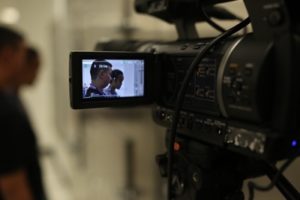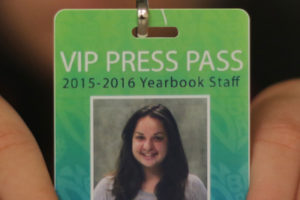
Searider Productions: Digital Media Applications
View
Visual Storytelling Guide
View
Helpful Info
Wide
a shot that is used to establish or reveal location
Medium
a shot that is used to identify subjects in the setting
Close up
a shot that is used to show emotion
Extreme close up
a shot that is used to focus on a specific detail
Compose
to make or create
Composition
what something is made of
Treatment
a summary of the story; a pitch
Sequence
a series of shots that tell a story
Editing
the process by which videos are trimmed and connected to create visual continuity
Camera angle
the angle at which the camera 'looks' in relation to the subject
Camera position
the placement of the camera in relation to the subject
ACO 3.1
Analyze how elements and principles of design in various forms of media are applied to communicate to a specific audience.
ACO 3.2
Critique how the effective integration of elements and principles of design within a variety of medium impact target audiences.
ACO 3.3
Apply elements and principles of design to clarify, focus, or enhance a message or concept for a target audience.
ACO 5.0
Create a deliverable using problem-solving techniques to address client needs or target audience.
ACO 3.1
- I can analyze how elements and principles of design in various forms of media are applied to communicate to a specific audience. (DOK 4)
- I can determine the meaning of key terms and other domain specific words and phrases are they are used in a specific technical context. (DOK 1)
- I can compare and contrast information gained from multimedia sources with that gained from reading a text on the same topic. (DOK 3)
- I can distinguish among facts, reasons, and judgment based on research findings and speculation in a text. (DOK 2)
- I can come to discussions prepared having read or researched material. (DOK 1)
- I can explicitly draw on that preparation by referring to evidence on the topic to probe and reflect on ideas under discussion. (DOK 3)
- I can follow rules for collegial discussions and decision-making. (DOK 1)
- I can track progress toward specific goals and deadlines. (DOK 1)
- I can pose questions that connect the ideas of several speakers and respond to others’ questions and comments with relevant evidence. (DOK 2)
- I can acknowledge new information expressed by others and justify my own views in light of the evidence presented. (DOK 3)
- I can analyze the purpose of information presented in diverse media (visually, quantitatively, orally) and evaluate the motives (social, commercial, political) behind its presentation. (DOK 4)
- I can present claims and findings, emphasizing points in a focused coherent manner with relevant evidence and details. (DOK 3)
- I can present claims using appropriate eye contact, adequate volume, and clear pronunciation. (DOK 1)
- I can integrate multimedia and visual displays into presentations to clarify information, strengthen claims and evidence. (DOK 3)
- I can produce clear and coherent writing with appropriate development, organization, and style. (DOK 4)
ACO 3.2
- I can critique how the effective integration of elements and principles of design within a variety of medium impact target audiences. (DOK 3)
- I can determine the meaning of key terms and other domain specific words and phrases are they are used in a specific technical context. (DOK 1)
- I can compare and contrast information gained from multimedia sources with that gained from reading a text on the same topic. (DOK 3)
- I can distinguish among facts , reasons, and judgment based on research findings and speculation in a text. (DOK 2)
- I can come to discussions prepared having read or researched material. (DOK 1)
- I can explicitly draw on that preparation by referring to evidence on the topic to probe and reflect on ideas under discussion. (DOK 3)
- I can follow rules for collegial discussions and decision-making. (DOK 1)
- I can track progress toward specific goals and deadlines. (DOK 1)
- I can pose questions that connect the ideas of several speakers and respond to others’ questions and comments with relevant evidence. (DOK 2)
- I can acknowledge new information expressed by others and justify my own views in light of the evidence presented. (DOK 3)
- I can analyze the purpose of information presented in diverse media (visually, quantitatively, orally) and evaluate the motives (social, commercial, political) behind its presentation. (DOK 4)
- I can present claims and findings, emphasizing points in a focused coherent manner with relevant evidence and details. (DOK 3)
- I can present claims using appropriate eye contact, adequate volume, and clear pronunciation. (DOK 1)
- I can adapt speech to a variety of contexts. (DOK 2)
- I can gather relevant information from multiple print and digital sources. (DOK 1)
ACO 3.3
- I can apply elements and principles of design to clarify, focus, or enhance a message or concept for a target audience. (DOK 3)
- I can determine the meaning of key terms and other domain specific words and phrases are they are used in a specific technical context. (DOK 1)
- I can integrate technical information expressed in a text with a version that is expressed visually. (DOK 3)
- I can come to discussions prepared having read or researched material. (DOK 1)
- I can follow rules for collegial discussions and decision-making. (DOK 1)
- I can track progress toward specific goals and deadlines. (DOK 1)
- I can pose questions that connect the ideas of several speakers and respond to others’ questions and comments with relevant evidence. (DOK 2)
- I can present claims and findings, emphasizing points in a focused coherent manner with relevant evidence and details. (DOK 3)
- I can present claims using appropriate eye contact, adequate volume, and clear pronunciation. (DOK 1)
- I can gather relevant information from multiple sources. (DOK 1)
- I can use search terms effectively. (DOK 1)
- I can assess the credibility and accuracy of sources. (DOK 2)
- I can quote or paraphrase data and conclusions of others while avoiding plagiarism. (DOK 1)
- I can follow a standard format for citations. (DOK 1)
ACO 3.1
- Formative:
- Teacher assessment of concepts
- Self-reflection
- Summative:
- Basic shot definitions (rubric)
- Focus statements (rubric)
- Composition techniques (rubric)
ACO 3.2
- Formative:
- Teacher assessment of concepts
- Self-reflection
- Check for understandings
- Clarifying questions
- Group assessment
- Summative:
- Groups’ assessment of photos (rubric)
ACO 3.3
- Formative:
- Teacher assessment of concepts
- Self-reflection
- Check for understandings
- Clarifying questions
- Group assessment
- Summative:
- 5 shot sequence activity (rubric)
- Treatment / Shot list (rubric)
- Group review (rubric)
ACO 5.0
- Formative:
- Teacher assessment of concepts
- Self-reflection
- Check for understandings
- Clarifying questions
- Group assessment
- Summative:
- How To Video (rubric)
- Treatment / Shot list (rubric)
- Group review (rubric)
Visual Storytelling Guide: Basic Shots
What We See
Every picture is viewed the same way. By understanding how people look at and gather information from pictures you can direct the eye and present a message without words.
Every visual, like every story, is made up of three key components. BEGINNING, MIDDLE, END. What you need to do is decide what is your SUBJECT and how people view it.

When looking at this picture what do you notice first, next and last?
Focus Statements
NOUN, VERB, NOUN
Create simple three word statements. It's an effective and efficient way to ensure you know what you want to shoot.
Focal Point


More commonly referred to as where the camera is focused, is important because eyes are obviously drawn to what is sharp. Amateurs often rely too heavily on Auto Focus to capture their images which often leads to their subjects being slightly out of focus. Pay close attention to your focal point to ensure a quality picture.
Rule of Thirds

By creating an imaginary grid and placing your subject at one of the intersect points, you can help draw eyes to your subject. This tool also helps create a balanced picture.
How it Works
So how does this help you? Let's look at a couple of examples. Below are two pictures, both have the same general subject - a student is holding a container. However they both convey two very distinct messages using focal point or rule of thirds.

FOCAL POINT
Depicts the idea that the most important thing is "what's in the container"

RULE OF THIRDS
Sends us the message that the student who is holding the container is the focus of the image.
Light

Our eyes are inevitably drawn to light. So if you want someone to look at something first make sure it’s lit well!
Size

Our eyes are naturally drawn to the biggest objects in the picture. If you want people to notice it first, make it BIG!
Contrast

Want people to notice your subject without using size or light? Contrasting colors and/or shapes can highlight your subject.
Fine Detail

After the larger parts of the picture our eyes wander the photo looking for any other information that conveys the message.

Framing
Extreme Wide

Extreme Wide (Landscape)
An Extreme Wide helps the audience understand general location of a story. It also helps frame the period of time the story takes place in.
Wide

Wide (Environment > Subject)
A Wide shot establishes the subject in relation to the surrounding environment. It can also still hide specific details.
Medium

Medium (Subject>Environment)
A Medium shot will be used to emphasize the subject, while still allowing the audience to distinguish where things are happening.
Close Up

Close Up (Details and Emotion)
These shots are used to bring details to the forefront of the audiences minds or when trying to convey specific emotions.
Extreme Close Up

Extreme Close Up (Specific Detail)
Use this shot when you want to show only one detail. The audience will be forced to look at one and only one thing.
Control the Message!


Framing is such a powerful tool. It can drastically change the outcome of your photo and alter the messaging. Remember "with great power comes great responsibility".
Go Extreme!




Understanding the difference between the two extremes will help you frame the proper message. Can you spot the differences between the two example below?
Check the Fine Print



No matter how good the picture is sometimes those fine details can sneak in an distract viewers from the message. High production value can only be achieved by those who pay attention to the details.
Parting Shots
Before we wrap this lesson up and move onto our activity, lets review what makes great visual storytelling. It doesn’t matter if you’re a big Hollywood production, designing a poster, shooting a photo or video, “The Basics” are something everyone uses.
Focus Statements
Simple Statements to focus your message.
Focal Point
What in your picture is in focus?
Rule of Thirds
An imaginary grid with intersect points.
Light, Size, Contrast, Fine Detail
Simple tools to help focus messages.
Framing
Control the field of view.
Activity
Project Duration: 1 Day | Groups: 1 (max) | Media : 10 Photos | Difficulty: Beginner
Task: Choose one of the following focus statements to capture a photo using each of the five framing techniques. Compose each shot using the rule of thirds. Upload your photos for review.
Objective: Students will demonstrate their understanding of basic visual storytelling through 5 photos.
CHOOSE ONE
Focus Statements
- Student drinks water
- Student reads book
- Student ties shoes
- Student recycles bottle
- Student eats snacks
SHOOT ALL FIVE
Frames
- Extreme Wide Shot
- Wide Shot
- Medium Shot
- Close Up Shot
- Extreme Close Up Shot


















